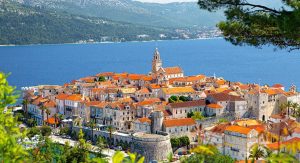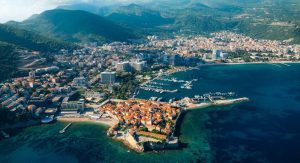Budva Montenegro Travel Guide — Have you ever dreamed of walking through a sunlit stone alley, surrounded by centuries-old walls, with the scent of the Adriatic Sea drifting through the air? That’s exactly the feeling Budva, Montenegro delivers — and it’s just the beginning. Known as the “Montenegrin Riviera,” Budva is a rare combination of ancient history, Mediterranean charm, and modern coastal energy.
In this guide, you’ll find everything you need to know about visiting Budva — from exploring its historic Old Town to finding the best beaches, navigating local culture, and uncovering tips only seasoned travelers know. By the end, you’ll feel fully prepared to make the most of your trip, whether it’s your first visit or your fifth.
Understanding Budva: A Quick Overview

Before diving into the specifics, let’s get a sense of what Budva is and why it’s such a magnet for travelers.
- Location: Budva is on Montenegro’s Adriatic coast, about 20 km from Tivat Airport and 65 km from Podgorica.
- Climate: It enjoys over 250 sunny days a year, with warm summers and mild winters.
- Reputation: Known for its beaches, nightlife, and historic charm, it’s a hotspot for both relaxation and entertainment.
- History: With more than 2,500 years of history, Budva is one of the oldest settlements on the Adriatic, blending Venetian, Byzantine, and Slavic influences.
Exploring Budva’s Old Town (Stari Grad)
Budva’s Old Town is the heart of its identity. Enclosed by stone walls and dotted with terracotta rooftops, it feels like stepping into another era.
Highlights Inside the Old Town
- Citadel Fortress – Offers panoramic views of the coastline and an insight into Budva’s defensive history.
- Church of St. John – Dating back to the 7th century, with a peaceful courtyard perfect for a quiet pause.
- Narrow Alleyways – Lined with small boutiques, art galleries, and family-run cafes.
- Town Walls Walk – Short but rewarding for views over the Adriatic and the city’s rooftops.
Pro Tip: Visit in the early morning or late evening to avoid the midday cruise-ship crowds.
Budva’s Beaches: Where to Soak Up the Sun

Budva’s coastline stretches over 20 km, offering a mix of sandy, pebbly, and secluded coves.
Popular Beaches
- Slovenska Beach – Long, lively, and close to the Old Town, with plenty of cafes and activities.
- Mogren Beach – Split into two sections connected by a short tunnel, this is one of the prettiest and most accessible beaches.
- Jaz Beach – Known for hosting music festivals and offering a mix of family areas and lively bars.
Hidden Gems
- Drobni Pijesak – Small, quiet, and surrounded by pine trees.
- Ploče Beach – A rocky terrace beach with natural pools, great for sunbathing and swimming.
Best Time to Visit Budva
- High Season (June–August): Lively atmosphere, warm sea, but crowded and pricier.
- Shoulder Season (May & September): Pleasant weather, fewer tourists, better hotel rates.
- Off-Season (October–April): Quieter, cooler, but Old Town remains beautiful year-round.
Local Food and Dining Tips
Montenegrin cuisine is a blend of Mediterranean and Balkan flavors. In Budva, you’ll find everything from rustic taverns to high-end restaurants.
Dishes to Try
- Njeguški pršut – Locally cured ham.
- Black risotto – Made with cuttlefish ink, rich and flavorful.
- Fresh Adriatic fish – Usually grilled and served simply with olive oil and herbs.
Dining Etiquette: Montenegrins value slow meals. Don’t rush; savor the moment and the view.
Nightlife and Entertainment
Budva is often called the nightlife capital of Montenegro.
- Top Hill – An open-air mega club with panoramic views.
- Beachfront bars – Ideal for sunset cocktails.
- Cultural events – In summer, the Old Town hosts theater performances, concerts, and art exhibitions.
Getting Around Budva
- On Foot – Old Town and main beaches are walkable.
- Taxi or Rideshare – Affordable for short trips, but agree on the price before getting in.
- Boat Taxis – Fun and scenic way to reach nearby beaches.
Day Trips from Budva
- Sveti Stefan – Iconic islet-hotel, perfect for photos and a quick visit.
- Kotor – UNESCO-listed bay town just an hour away.
- Lovćen National Park – Mountain scenery and the mausoleum of Montenegro’s poet-prince Njegoš.
Common Mistakes to Avoid
- Underestimating the heat – Always carry water and sunscreen in summer.
- Only visiting in peak season – Shoulder season can be more enjoyable.
- Not exploring beyond the Old Town – Budva’s surroundings are just as rewarding.
Travel Tips from Experienced Visitors
- Book accommodation early in July and August.
- Learn a few Montenegrin phrases — locals appreciate the effort.
- Use cash in small establishments; not everywhere accepts cards.
Industry Insights: Budva’s Growing Appeal
Tourism in Budva has expanded rapidly in the past decade, with a growing mix of boutique hotels, wellness resorts, and cultural festivals. However, locals are also pushing for more sustainable tourism practices to preserve the charm that draws visitors in the first place.
FAQ: Budva, Montenegro Travel Guide
Q: Is Budva safe for tourists?
A: Yes, Budva is generally safe. Use common sense with belongings, especially in crowded areas.
Q: Can I swim in October?
A: The sea is still warm in early October, but temperatures drop later in the month.
Q: How many days do I need in Budva?
A: 3–4 days is ideal to enjoy Old Town, beaches, and nearby attractions.
Q: Are beaches free in Budva?
A: Many have free sections, but sunbed rentals are common on the main beaches.
Q: What currency is used?
A: Montenegro uses the Euro (€), even though it’s not in the EU.
Final Thoughts
Budva is more than just a beach destination — it’s a place where history, culture, and coastal beauty intertwine. From strolling through its medieval streets to diving into the Adriatic, every moment here offers a chance to slow down and savor life. Whether you’re chasing sunsets, history, or simply a relaxing escape, Budva has a way of staying with you long after you’ve left.
